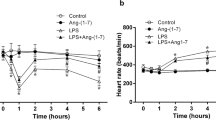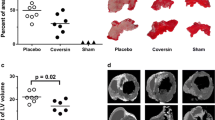Abstract
The effect of the platelet activating factor antagonist RP 59227 (Tulopafant) on myocardial infarct size was compared to that of vehicle-treated control group in barbital-anesthetized dogs subjected to 90 min of left circumflex coronary artery occlusion and 5 h of reperfusion. The myocardial region at risk and infarct size were determined by the triphenyltetrazolium histochemical technique and regional myocardial blood flow by radioactive microspheres. Myeloperoxidase (MPO) activity was used as an index of neutrophil infiltration into the ischemic-reperfused area. Vehicle (n=11) or RP 59227 (n=12, 2.5 mg/kg i.v.) were administered 15 min prior to occlusion. Hemodynamics and regional myocardial blood flow in the ischemic-reperfused areas did not differ between the two groups throughout the experiment. In contrast, the number of dogs which developed ventricular fibrillation during occlusion and reperfusion was significantly less in RP 59227-treated dogs (8 of 11 in the control group vs. 3 of 12 in the RP 59227-treated group, p<0.05). Myocardial infarct size expressed as a percent of the area at risk (control, 39.0±5.0; RP 59227, 24.8±3.4%) or as a percent of the left ventricle (control, 15.3±1.9; RP 59227, 9.0±1.3%) was significantly smaller in the RP 59227-treated group. Infarct size was inversely related to the collateral blood flow in the inner two thirds of the left ventricular wall of the infarct area, and this relationship was shifted downward in the RP 59227-treated group (p<0.05). MPO activity in the border zone immediately adjacent to infarcted tissue was reduced in the RP 59227-treated dogs (control, 7.4±0.5 U/g; RP 59227, 4.1±0.4 U/g). In additional in vitro studies, the addition of PAF was found to elicit a concentration-dependent potentiation in chemiluminescence produced by purified canine neutrophils, a measure of oxygen-derived free radicals, which was stimulated with a low concentration of opsonized zymosan. Preincubation of neutrophils with RP 59227 resulted in a concentration-dependent decrease in chemiluminescence produced by PAF primed cells. Taken together, these data demonstrate that RP 59227 effectively reduces myocardial infarct size and reduces the incidence of ischemia and reperfusion-induced arrhythmias in barbital-anesthetized dogs, and support the concept that PAF plays an important role in the pathogenesis of acute myocardial infarction.
Similar content being viewed by others
Author information
Authors and Affiliations
Additional information
Received: 11 March 1998, Returned for 1. revision: 2 April 1998, 1. Revision received: 18 May 1998, Accepted: 18 May 1998
Rights and permissions
About this article
Cite this article
Auchampach, J., Pieper, G., Cavero, I. et al. Effect of the platelet-activating factor antagonist RP 59227 (Tulopafant) on myocardial ischemia/reperfusion injury and neutrophil function. Basic Res Cardiol 93, 361–371 (1998). https://doi.org/10.1007/s003950050104
Issue Date:
DOI: https://doi.org/10.1007/s003950050104




